Andhra Pradesh BIEAP AP Inter 2nd Year English Study Material Intermediate 2nd Year English Grammar Interpretation of Non-verbal Information Questions and Answers.
AP Intermediate 2nd Year English Grammar Interpretation of Non-verbal Information
Introduction : We use Non-verbal communication to express several types of important information. At a glance we can understand the information through different charts. Bar charts, Pie-charts, Tree charts, Tables, Flow charts and Tree diagrams are some of the commonly used Non-verbal devices.
- Bar charts give information regarding the growth or decrease of certain phenomena or an industry.
- A pie-chart is used to represent information relating to the composition of a particular item in terms of percentages.
- A tree diagram can be used to present the structure of an organization.
- A table format can handle huge data and makes it easy for the readers to look for information.
- A flow chart represents a process that takes place in successive stages as in production process from raw material to finished products.
Pie-chart
Observe the following pie diagrams carefully. Then answer the questions given after them.
A. Pie chart showing the amount of water we use of different purposes.
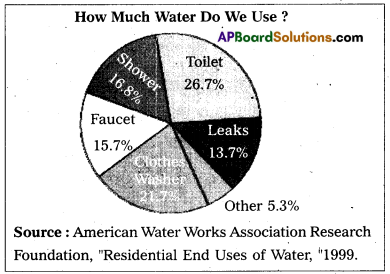
Questions :
Question 1.
What does the pie chart show ?
Answer:
The amount of water we use for different purposes.
Question 2.
For what do we use maximum water ?
Answer:
Toilet.
![]()
Question 3.
How many types of usage of water is taken into consideration in the diagram ?
Answer:
Six (6).
Question 4.
How much water is wasted on leaks ?
Answer:
13.7%.
Question 5.
What is the source of the information ?
Answer:
American Water Works Association, Research Foundation.
B. Pie chart showing the major sources of energy for our requirements in India.
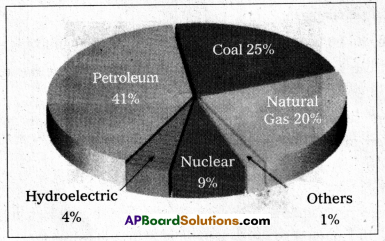
Questions :
Question 1.
What does the pie chart show ?
Answer:
The major sources of energy for our requirement in India.
Question 2.
State true or false.
Natural gas and coal put together is almost equal to our major source of energy.
Answer:
True.
Question 3.
What is the second major source of energy in our country ?
Answer:
Coal.
![]()
Question 4.
How many sources of energy are taken into consideration ?
Answer:
Six (6).
Question 5.
What is hydroelectric power ?
Answer:
Electricity produced with water.
C. Here is the pie chart showing the recommended diet for a normal healthy person.

Questions :
Question 1.
What does the pie chart show ?
Answer:
The recommended diet for a normal, healthy person.
Question 2.
What should be the major part of our diet according to the diagram ?
Answer:
Fruit.
Question 3.
State true or false.
Fruit and protein put together cover almost half of our diet.
Answer:
True.
Question 4.
Give two examples of dairy products.
Answer:
Milk, Curd, Buttermilk, Ghee, Cheese, Paneer etc.
![]()
Question 5.
How much percentage of vegetables should a healthy person have in his/her diet ?
Answer:
18%.
D. The following pie chart is about the percentage of people in the U.S. who speak different languages of the Indian subcontinent.
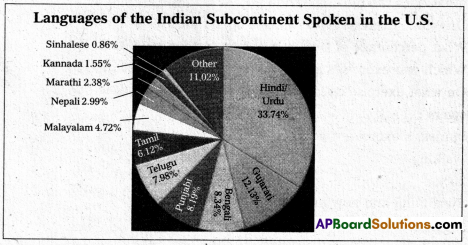
Questions :
Question 1.
What does the pie chart show ?
Answer:
Languages in the Indian subcontinent spoken in the U.S.
Question 2.
How many languages have been taken into consideration ?
Answer:
12/ more than 12.
Question 3.
What is the major Indian language spoken in the U.S. ?
Answer:
Hindi/Urdu.
Question 4.
Which position does Telugu stand in the pie chart from the highest to the lowest order ?
Answer:
Fifth position.
![]()
Question 5.
Which of our neighbouring countries speak Sinhalese ?
Answer:
Srilanka.
E. The following diagram shows the time spent by Marissa on different types of exercise each week.
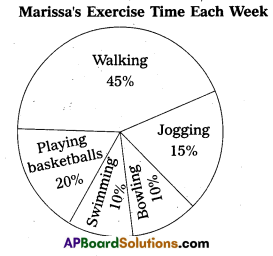
Questions :
Question 1.
What does the pie chart show ?
Answer:
Marissa’s exercise time each week.
Question 2.
On which exercise does Marissa spend most time ?
Answer:
Walking.
Question 3.
What percentage of time is spent on playing basketball ?
Answer:
20%.
Question 4.
Which two exercises are given equal percentage of time ?
Answer:
Swimming and bowling.
Question 5.
On what exercise does Marissa spend 15% of her time ?
Answer:
Jogging.
Tree diagrams
Study the following tree diagrams and answer the questions that follow.
A. The following tree diagram shows the structure of a simple sentence. S-sentence, NP- noun phrase, VP – verb phrase, Det – determiner, N – noun, V – verb, PP – Prepositional phrase, P – preposition.
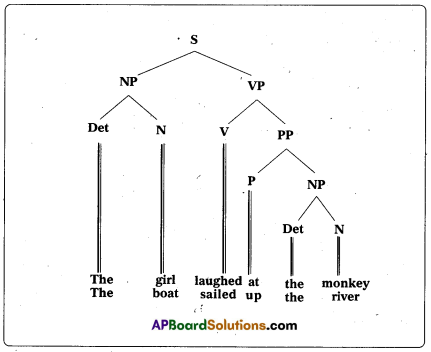
Questions :
Question 1.
What are the two main sub-divisions of a sentence ?
Answer:
NP and VP.
![]()
Question 2.
What does the NP contain ?
Answer:
Determiner and noun.
Question 3.
What is THE called in the diagram ?
Answer:
Determiner.
Question 4.
What sub-divisions does PP have ?
Answer:
Preposition and noun phrase.
Question 5.
How many types of phrases do you notice in the tree diagram ? What are they ?
Answer:
Three (3), noun phrase, verb phrase and prepositional phrase.
B. The following tree diagram shows types of verbs.

Questions :
Question 1.
How many types of verbs are shown in the diagram ?
Answer:
Six types (6).
Question 2.
HAVE is a type of —— verb.
Answer:
Primary auxiliary.
Question 3.
State true or false.
Transitive verbs are again divided into regular and irregular verbs.
Answer:
True.
Question 4.
A modal verb is a sub-division of a(n) —- verb.
Answer:
Auxiliary.
![]()
Question 5.
Give two examples of modal verbs from the diagram.
Answer:
Will, can, may, must, would, could etc.
C. Here is a tree diagram showing different reasons for the satisfaction of customers.

Questions :
Question 1.
What are the main reasons for the satisfaction of customers ?
Answer:
Good food, Good service, Good surroundings.
Question 2.
Good food depends on —- according to the diagram.
Answer:
Quality ingredients and good recipe.
Question 3.
State true or false.
Happy atmosphere comes under good service.
Answer:
False.
Question 4.
Write a synonym for ‘prompt’.
Answer:
Quick, fast, immediate, instant, speedy.
Question 5.
What is a recipe ?
Answer:
Recipe – a set of instructions for preparing food dishes.
D. The following tree diagram shows how running is a good investment of time.
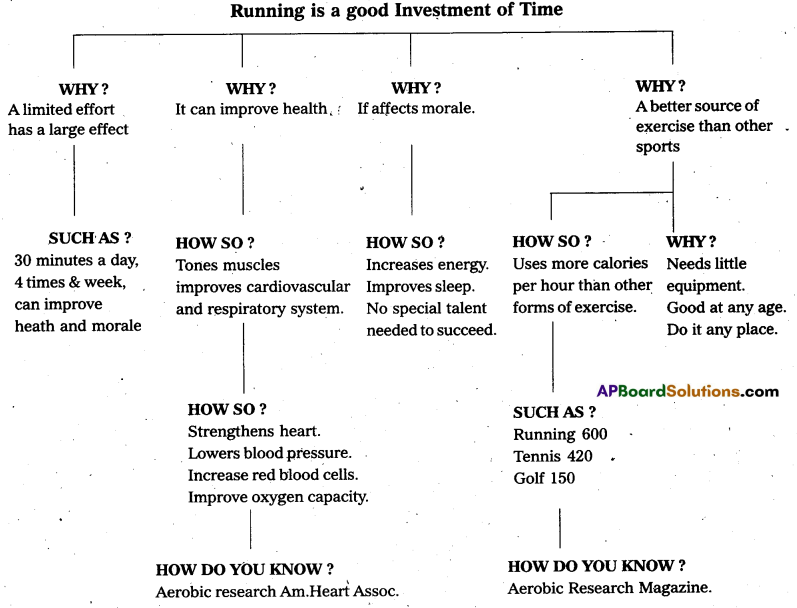
Questions :
Question 1.
How many reasons are given to show that running is a good investment of time ?
Answer:
Four (4).
Question 2.
Is running good for all ages people ?
Answer:
Yes.
![]()
Question 3.
How does running affect the morale of a person ?
Answer:
Increase energy improves sleep, no special talent needed to succeed.
Question 4.
How do you know that running burns 600 calories per hour ?
Answer:
From Aerobic Research Magazine.
Question 5.
Why is running considered a better source of exercise than other sports ?
Answer:
Needs little equipment, good at any age, do it any place.
E. The following tree diagram shows the different types of human memory.

Questions :
Question 1.
Basically how many types of memory do we have ?
Answer:
Three (3).
Question 2.
Which of the main sub-divisions has further divisions ?
Answer:
Long-term memory.
![]()
Question 3.
State true or false.
Unconscious/memory is also known as implicit memory.
Answer:
True.
Question 4.
What comes under episodic memory ?
Answer:
Events and experiences.
Question 5.
Short term memory lasts for —-.
Answer:
Less than one minute/ < 1 min.
Tables
Study the following tables carefully and answer the questions that follow.
A. The following table shows the different types of boats, their number and the number of persons employed to ride the boat.

Questions :
Question 1.
How many types of boats are shown in the diagram ?
Answer:
Six (6).
Question 2.
State true or false.
The total number of persons employed is less than the total number of boats.
Answer:
False.
Question 3.
Maximum number of persons are employed for —– boats.
Answer:
Tourist House boats.
Question 4.
Which type of boats is lowest in quantity ?
Answer:
Passenger boats (tourist doonga).
Question 5.
The total number of the passenger boats is —–.
Answer:
1152 + 275 = 1427.
B. The following table gives information about the immigrant population from India living in the metropolitan cities of the U.S A.
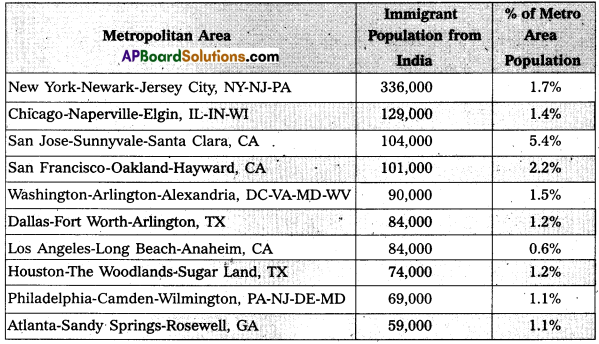
Questions :
Question 1.
What is the table about ?
Answer:
The immigrant population from India living in metropolitan cities of U.S.
Question 2.
How many metropolitan cities are listed here ?
Answer:
Ten (10).
Question 3.
Which city has the maximum number of immigrant Indian population ?
Answer:
New York.
![]()
Question 4.
Which city has the minimum percentage of immigrant Indian population ?
Answer:
Los Angeles.
Question 5.
Write the antonym of immigrant.
Answer:
Emigrant, native, non immigrant.
C. The following table is about the number of farmer’s suicide in different states.
Farmers’ suicides :
(includes those by farm labourers)
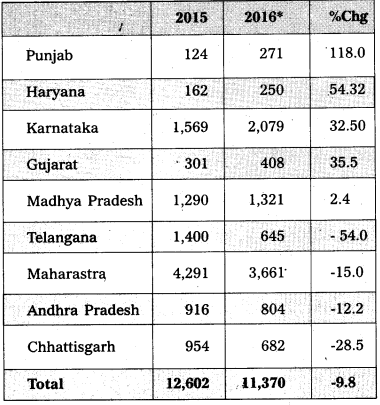
Note : Total might not match, as all states have not been included.
Source : Parliament questions.
Questions :
Question 1.
Did the number of suicides increase from 2015 to 2016 in all states ?
Answer:
No.
Question 2.
Which state has the lowest number of suicides in 2016 ?
Answer:
Haryana.
Question 3.
What is the place of AP in the list taking into consideration the number of suicides from top to bottom in 2015 ?
Answer:
Sixth place.
Question 4.
What is the source of this information ?
Answer:
Parliament questions.
Question 5.
State true or false.
The numbers in the above table show only the farmers’ suicides in different states.
Answer:
False.
D. The following table shows the best and worst foods for health.

Questions :
Question 1.
Give examples of foods having trans-fats in them.
Answer:
Stick margarine, shortening, fast foods, commercial baked foods.
Question 2.
Are sesame and sunflower seeds good for health.
Answer:
Yes.
![]()
Question 3.
State true or false.
Cauliflower and broccoli cause damage to our health.
Answer:
False.
Question 4.
Write down two white coloured foods from the table which are not good for our health ?
Answer:
White sugar, white flour.
Question 5.
What does longevity in this table mean ?
Answer:
Long life/having long life.
E. The following table is about the world’s most expensive cities.
These are the world’s most expensive cities
Based on the goods and services purchased by a three-person family, 2018
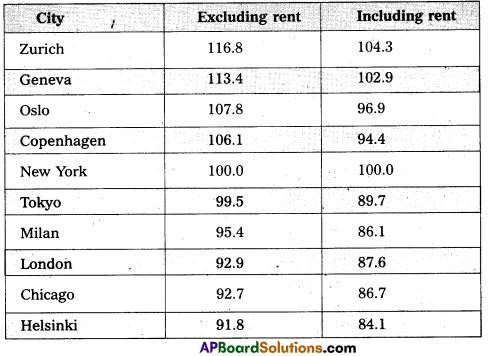
Source: UBS
Questions :
Question 1.
Which city is the least expensive excluding rent ?
Answer:
Helsinki.
Question 2.
Which city has the same expense with or without rent ?
Answer:
New York.
Question 3.
State true or false.
The expense is calculated based on the goods and services purchased by a five- persons family.
Answer:
False.
Question 4.
Which two cities are almost the same in terms of including rent, but different excluding rent ?
Answer:
Milan and Chicago.
Question 5.
How many countries are listed in the table ?
Answer:
Ten (10).
Bar graphs
Study the following bar graphs carefully and answer the questions that follow.
A. The following bar graph depicts the favourite sports of a group of students.
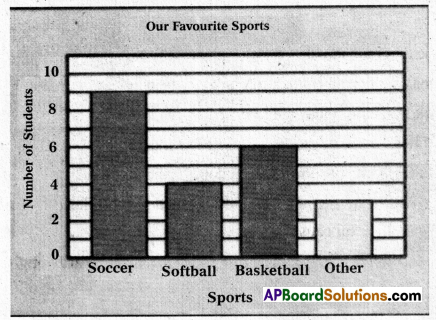
Questions :
Question 1.
What does the graph depict ?
Answer:
The favourite sports of a group of students.
![]()
Question 2.
Which is the most liked game ?
Answer:
Soccer.
Question 3.
State true or false.
The number of students who like basketball and other games is equal to the number of students who like soccer.
Answer:
True.
Question 4.
Which sport is liked by only 6 students ?
Answer:
Basketball.
Question 5.
How many students like softball ?
Answer:
Four (4).
B. The following bar graph shows week-wise sales of a certain product in the months of July and August.

Questions :
Question 1.
What does the diagram show ?
Answer:
Week-wise sales of a certain product in the months of July and August.
Question 2.
What is the maximum sale in each month ?
Answer:
July – 900, August – 900.
Question 3.
In which week and month was the sales least ?
Answer:
1st week of July.
Question 4.
State true or false.
In the month of July maximum sale was done in the last week.
Answer:
True.
Question 5.
The sales of —- week in the month of July is equal to the sales of —- week in the month of August.
Answer:
4th week, 2nd week.
C. The following bar graph shows some school supplies used by school students.

Questions :
Question 1.
How many school supplies are taken into consideration ?
Answer:
Five (5).
Question 2.
Which of these school supplies used most by the students ?
Answer:
Pencil.
![]()
Question 3.
The third place from the most used to the least used is occupied by —- in the diagram.
Answer:
Eraser.
Question 4.
The number of scale and pen put together is equal to the number of erasers.
State true or false.
Answer:
False.
Question 5.
On the total, what is the number of all the supplies ?
Answer:
22.
D. The following bar graph shows the number of rhinoceros poached in South Africa from 2007 to 2015.
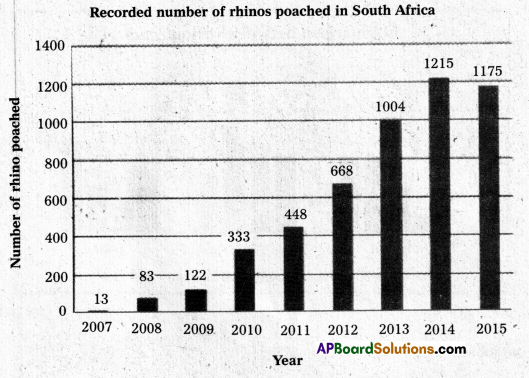
Questions :
Question 1.
In which year were the maximum rhinos poached ?
Answer:
2014.
Question 2.
Explain if poaching decreased or increased from 2007 to 2015.
Answer:
Poaching increased from 2007 to 2014 and decreased a bit in 2015.
Question 3.
During which years can we observe the maximum difference in the number of rhinos poached ?
Answer:
2012 to 2013.
Question 4.
A person who poaches is called a —–.
Answer:
Poacher.
Question 5.
State true or false.
The number of rhinos poached in 2014 is almost double to the number, poached in 2012.
Answer:
True.
E. The following bar graph gives us a comparison between three types of cars relating to some chosen features.

Questions :
Question 1.
What is the graph about ?
Answer:
Comparison between three types of cars relating to some chosen features.
Question 2.
Which car has the best mileage ?
Answer:
Audi.
Question 3.
Which is the safest car ?
Answer:
Ford.
![]()
Question 4.
Taking all the features into consideration which car can be chosen as the best ?
Answer:
Audi.
Question 5.
Which car has equal measure of mileage and safety features ?
Answer:
Fiat.
Flow charts
Study the following flow charts carefully and answer the questions that follow.
A. The following flow chart is about the preparation of a sweet called Shrikhand.

Questions :
Question 1.
How many steps are involved in the preparation of Shrikhand ?
Answer:
Ten (10).
Question 2.
What are the main ingredients of this sweet ? Name at least three.
Answer:
Cow’s milk, soy milk, sugar, inoculum, yoghurt, whey, chakka, flavour.
Question 3.
Pick another name of yoghurt from the flow chart.
Answer:
Curd.
Question 4.
In which step is the flavour added ?
Answer:
9th step/last but one step.
Question 5.
Incubation should be done for —- hours.
Answer:
Two hours.
B. The following flow chart is about the steps involved in learning an essay question.
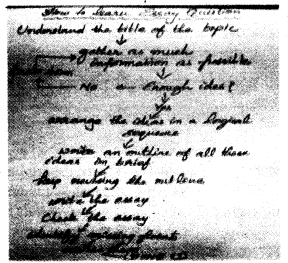
Questions :
Question 1.
What is the first step in the process of learning an essay question ?
Answer:
Understand the title of the topic.
Question 2.
What should we do if we do not have enough ideas ?
Answer:
Brain storm/brain storm and gather as much information as possible.
![]()
Question 3.
What should we check in the written essay ?
Answer:
Identify the missing points.
Question 4.
How many steps are involved in learning an essay according to this flow chart ?
Answer:
Twelve (12).
Question 5.
When should we write the essay ?
Answer:
After revising the outline.
C. The following flow chart shows how water is purified before it is supplied to the public in a place.
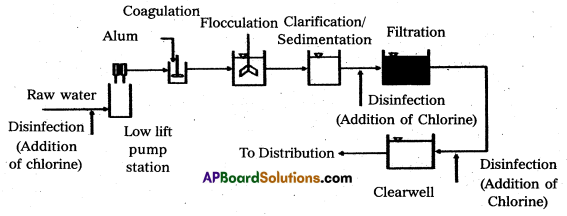
Questions :
Question 1.
What does the diagram show ?
Answer:
How water is purified before it is supplied to the public in a place.
Question 2.
Which disinfectant is added twice to water ?
Answer:
Chlorine.
Question 3.
What is the step called in which alum is added ?
Answer:
Coagulation.
![]()
Question 4.
How marry steps are there before distribution ?
Answer:
Six (6).
Question 5.
After the whole process of purification, where is water stored ?
Answer:
Clear well.
D. The following flow chart shows how the nervous system reacts when we touch a hot stove.

Questions :
Question 1.
What happens at first when we touch a hot stove ?
Answer:
The sensory receptors in the skin of your hand detect heat.
Question 2.
Where is the impulse first carried to ?
Answer:
The impulse is first carried to the spinal cord.
Question 3.
State true or false.
The spinal cord interprets the impulse as “Ouch! That was hot!”
Answer:
False.
Question 4.
Which nerves carry the impulse from spinal cord to hand muscle ?
Answer:
Motor nerves.
Question 5.
—– sends impulse to hand muscles and brain simultaneously.
Answer:
Spinal cord.
E. The following flow chart shows the preparation of jaggery.
Flow Chart for Jaggerv Manufacturing process
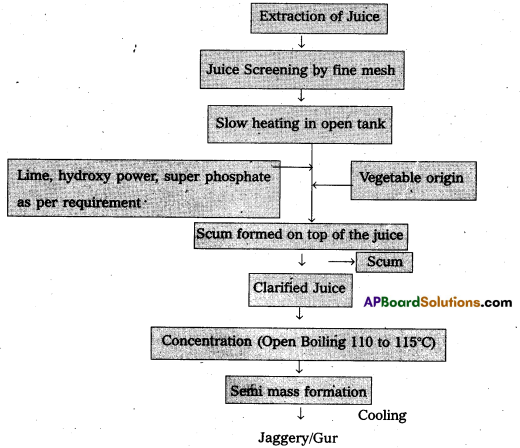
Questions :
Question 1.
What is the flow chart about ?
Answer:
Jaggery manufacturing process/the preparation of jaggery.
![]()
Question 2.
How is the juice screened ?
Answer:
With a fine mesh.
Question 3.
When is super phosphate added to in the juice ?
Answer:
While slow heating in open tank is being done.
Question 4.
What is scum ?
Answer:
Scum is a layer of dirt/impurity/a layer of impurities that accumulates at the surface of a liquid.
Question 5.
At what temperature is the clarified juice boiled ?
Answer:
110 degrees to 115 degrees C